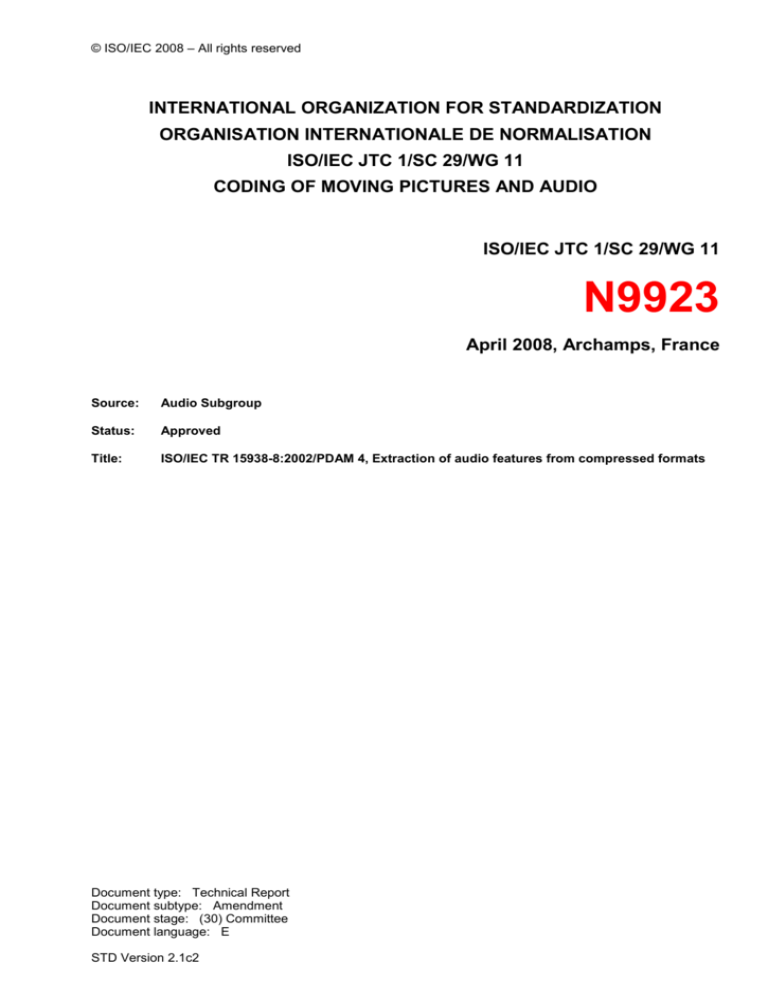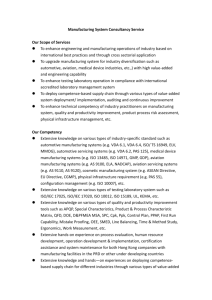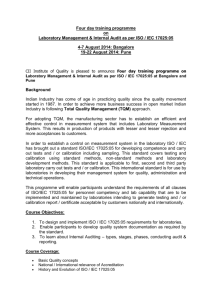
© ISO/IEC 2008 – All rights reserved
INTERNATIONAL ORGANIZATION FOR STANDARDIZATION
ORGANISATION INTERNATIONALE DE NORMALISATION
ISO/IEC JTC 1/SC 29/WG 11
CODING OF MOVING PICTURES AND AUDIO
ISO/IEC JTC 1/SC 29/WG 11
N9923
April 2008, Archamps, France
Source:
Audio Subgroup
Status:
Approved
Title:
ISO/IEC TR 15938-8:2002/PDAM 4, Extraction of audio features from compressed formats
Document type: Technical Report
Document subtype: Amendment
Document stage: (30) Committee
Document language: E
STD Version 2.1c2
ISO/IEC JTC 1/SC 29 N
Date: 2008-05-2
ISO/IEC TR 15938-8:2002/PDAM 4
ISO/IEC JTC 1/SC 29/WG 11
Secretariat:
Information technology — Multimedia content description interface —
Part 8: Extraction and use of MPEG-7 descriptions, AMENDMENT 4:
Extraction of audio features from compressed formats
Élément introductif — Élément central — Partie 8: Titre de la partie
Warning
This document is not an ISO International Standard. It is distributed for review and comment. It is subject to
change without notice and may not be referred to as an International Standard.
Recipients of this draft are invited to submit, with their comments, notification of any relevant patent rights of
which they are aware and to provide supporting documentation.
ISO/IEC TR 15938-8:2002/PDAM 4
Copyright notice
This ISO document is a working draft or committee draft and is copyright-protected by ISO. While the
reproduction of working drafts or committee drafts in any form for use by participants in the ISO standards
development process is permitted without prior permission from ISO, neither this document nor any extract
from it may be reproduced, stored or transmitted in any form for any other purpose without prior written
permission from ISO.
Requests for permission to reproduce this document for the purpose of selling it should be addressed as
shown below or to ISO's member body in the country of the requester:
[Indicate the full address, telephone number, fax number, telex number, and electronic mail address, as
appropriate, of the Copyright Manger of the ISO member body responsible for the secretariat of the TC or
SC within the framework of which the working document has been prepared.]
Reproduction for sales purposes may be subject to royalty payments or a licensing agreement.
Violators may be prosecuted.
© ISO/IEC 2008 – All rights reserved
iii
ISO/IEC TR 15938-8:2002/PDAM 4
Foreword
ISO (the International Organization for Standardization) and IEC (the International Electrotechnical
Commission) form the specialized system for worldwide standardization. National bodies that are members of
ISO or IEC participate in the development of International Standards through technical committees
established by the respective organization to deal with particular fields of technical activity. ISO and IEC
technical committees collaborate in fields of mutual interest. Other international organizations, governmental
and non-governmental, in liaison with ISO and IEC, also take part in the work. In the field of information
technology, ISO and IEC have established a joint technical committee, ISO/IEC JTC 1.
International Standards are drafted in accordance with the rules given in the ISO/IEC Directives, Part 2.
The main task of the joint technical committee is to prepare International Standards. Draft International
Standards adopted by the joint technical committee are circulated to national bodies for voting. Publication as
an International Standard requires approval by at least 75 % of the national bodies casting a vote.
In exceptional circumstances, the joint technical committee may propose the publication of a Technical Report
of one of the following types:
—
type 1, when the required support cannot be obtained for the publication of an International Standard,
despite repeated efforts;
—
type 2, when the subject is still under technical development or where for any other reason there is the
future but not immediate possibility of an agreement on an International Standard;
—
type 3, when the joint technical committee has collected data of a different kind from that which is
normally published as an International Standard (“state of the art”, for example).
Technical Reports of types 1 and 2 are subject to review within three years of publication, to decide whether
they can be transformed into International Standards. Technical Reports of type 3 do not necessarily have to
be reviewed until the data they provide are considered to be no longer valid or useful.
Attention is drawn to the possibility that some of the elements of this document may be the subject of patent
rights. ISO and IEC shall not be held responsible for identifying any or all such patent rights.
Amendment 4 to ISO/IEC TR 15938-8:2002 was prepared by Joint Technical Committee ISO/IEC JTC 1,
Information technology, Subcommittee SC 29, Coding of audio, picture, multimedia and hypermedia
information.
iv
© ISO/IEC 2008 – All rights reserved
COMMITTEE DRAFT
ISO/IEC TR 15938-8:2002/PDAM 4
Information technology — Multimedia content description
interface — Part 8: Extraction and use of MPEG-7 descriptions,
AMENDMENT 4: Extraction of audio features from compressed
formats
1. Introduction
Due to efficient MPEG audio compression technologies, such as MPEG 1 – Layer 3 or MPEG 2 Audio (AAC),
the number of personal and institutional music stored in archives grew significantly during the last years. At
the same time, the need for automatic search and retrieval capabilities for music increased in order to manage
these databases. These search and retrieval applications base on low-level features (e.g. described in the
MPEG-7 standard) which are extracted from the digital audio content. In order to efficiently search in large
archives, there is need to perform a faster low-level feature extraction. This technical report describes a
method, which allows an extraction of MPEG-7 low-level features directly from the compressed domain, by
transforming the frequency representation of MPEG compressed audio files into the DFT domain for feature
extraction.
2. Conventional Feature Extraction
The conventional approach to obtain MPEG-7 features from compressed audio data is to decode it first and
then to generate the MPEG-7 features based on the decoded time signal. But especially when searching large
libraries of compressed audio files this approach can become computationally very expensive. Several works
deal with the conversion between subband domain representations, especially in the field of image and video
coding. In [2, 3] the conversion between different sizes of DCT transforms is given, having the drawback that
they are restricted to non-lapped transforms. The patent in [4] proposes a conversion method between the
MDCT and the DFT domain. It is restricted to MDCT and DFT and therewith not suitable for our purposes,
since we want to include also hybrid filter banks, an integral part of MP3. The architecture presented in [5] is
not restricted to the type of filter banks used. Unfortunately, the number of subbands of the different filterbanks
have to be multiples of each other and this is again unsuitable for our needs. However, this paper serves as
the basis for a general conversion method proposed in [6], which can be applied to any maximally-decimated
filter bank without condition on their sizes. Here, a conversion matrix is generated by multiplying the analysis
with a synthesis filter bank. Principally, the same is done in this technical report, though, a universal
mathematical description is used, the polyphase description introduced in [7]. Additionally, the described
method is extended by applying it to arbitrary resolution translations between synthesis and analysis filter
banks in a practical way. Furthermore, it is adjusted to MP3 and AAC, and exploit some special properties of
the so-called conversion matrix which is explained in the next section. In [8] the problem of generating a
complex from a real valued spectral representation is picked up from the reverse side. Therein it is said that a
desired frequency response can be approximated by means of a linear combination with constant weighting
factors. This approach only allows a coarse approximation, nonetheless, having a very small computational
complexity load. This approach gave the inspiration for the issue termed as spectral approximation (see
section 3.2). A completely different approach is worth mentioning here which works directly on the
compressed domain. It uses the MDCT coefficients as the basis for the low level feature extraction [9]. Since
there is no conversion into the DFT domain applied, this approach is restricted to the time/frequency
resolution provided by the used codec. It is hence not compatible to existing MPEG-7 feature databases.
© ISO/IEC 2008 – All rights reserved
1
ISO/IEC TR 15938-8:2002/PDAM 4
3. Feature extraction directly from the encoded audio file
A conversion system which directly converts the given time/frequency representations of MPEG audio codecs
into the time/frequency representation has been designed, which is needed for MPEG-7 features. This is
realized by using special conversion matrices, whereas the time/frequency resolution as well as the accuracy
of the resulting spectrum is freely scalable. To derive these matrices, a mathematical approach in the zdomain has been chosen, the polyphase description, addressed in [7]. Using it, e.g. the MP3 decoder filter
banks (MDCT, QMF) and the STFT (Short Time Fourier Transform) for the MPEG-7 feature extraction can be
described with polyphase matrices. The polyphase description allows to derive conversion matrices, which
directly convert the given time/frequency representation into the desired one. The resulting complex spectral
coefficients are then fed to the feature extraction algorithm. Additionally, those matrices are suitable for a fast
implementation, since the most significant values are evenly spread along the main diagonal, whereas they
decrease quickly the further we move away from it. This property admits to approximate a desired spectral
representation by only calculating the strongest diagonals while omitting the multiplications with the less
important ones. The complexity of this approach is closely related to the accuracy needed for the identification
of an audio file. To determine this accuracy, this is showed by identification results of tests per formed on a
large audio library with diffeerent levels of conversion accuracy. These tests further show that the audio
feature extraction system can deal with very coarse spectral approximations. Exploiting this property leads, in
general, to a reduction of the computational complexity of the conversion from O(N logN) to O(N), compared to
the conventional approach. The new feature extraction system targets the MP3 and AAC formats, but is
generally applicable to any subband coder. However, there is one significant difference between the
mentioned two formats. MP3 uses a hybrid filter bank comprising a 32-band QMF and a switchable 6=18 band
MDCT, whereas AAC only uses an MDCT which can be switched between 128 and 1024 bands.
Figure 1: Block diagram of the conventional transcod-ing and of the direct conversion method.
3.1. Conversion System
An overview of the conversion system is presented in Fig. 1, where the upper half shows the conventional
transcoding scheme and the lower half our direct conversion approach. In conventional transcoding, the time
signal ^X(z) is first reconstructed and then transformed into the targeted frequency representation. This
intermediate step of calculating the time signal is avoided by our direct conversion approach, where the
conversion matrix T(z) is the matrix product of the polyphase matrices of the decoder synthesis filter bank G(z)
and the analysis filter bank H(z) of the feature extraction system. A more detailed mathematical description
can be found in [10].
3.2. Spectral Approximation
The most important characteristic of a conversion matrix T(z) is that it exhibits a strong similarity to diagonal
and therefore sparse matrices. For instance, Fig. 2 shows an example of such a polyphase conversion matrix,
2
© ISO/IEC 2008 – All rights reserved
ISO/IEC TR 15938-8:2002/PDAM 4
where the white areas corresponds to zeros in the matrix. Observe that three images of matrices can be used,
because each corresponds to the coefficients of a different power of z of the polyphase matrix. The analysis
time window is set to 30 ms because it is suitable for many tasks of music information retrieval. The sampling
frequency is chosen to be 44:1 kHz (generally it is arbitrary), hence the matrix generates 1024 complex
Fourier coefficients as output, whereas it takes 576 (the content of one MP3 granule) real valued input
samples.
Figure 2: Exemplary complex polyphase conversion matrix for MP3 converting one granule of
576 real valued subbands into 1024 DFT coecients. The figure only shows absolute values.
It can be seen in Fig. 2 that the most significant values are evenly spread along the main diagonal. If only the
coefficients necessary for the desired accuracy are kept, the sparse matrix shown in Fig. 3 is obtained. For
clarification, Fig. 4 shows an exemplaric STFT spectrum and its approximation using sparse matrices for
direct conversion. For this example a conversion complexity of about 0:07% in contrast to a fully populated
matrix was used.
4. Evaluation
4.1. Complexity
In this paragraph we assess the computational complexity of the conventional MP3 decoding process that is
followed by an FFT and compare it to the new approach in more detail. Standard methods as well as highly
optimized ones are used. Table 1 lists the number of multiplications and additions for the conventional
approach. For the standard method, the number of calculations is obtained by postulating full complexity. For
instance, a standard 32-DFT needs 322 = 1024 multiplications and 32*32 = 992 additions. The data for figuring
the computational amount of the optimized variants are extracted from three different papers.The data of the
optimized variants are extracted from [11, 12, 13]. In [12], Konstantinides found a fast implementation for QMF
filter banks based on Lee's fast DCT algorithm [14]. Marovich then reuses these results in [11] to reduce the
complexity of the IMDCT. For estimating the number of calculation steps of an optimized DFT, a highly
performant Split Radix Fast Fourier Transform (SRFFT) algorithm was chosen [13].
© ISO/IEC 2008 – All rights reserved
3
ISO/IEC TR 15938-8:2002/PDAM 4
Figure 3: Sparse polyphase matrix obtained from the conversion matrix shown in Fig. 2. Only the
biggest diagonal values are maintained.
Thus, by using optimized implementations for decoding and analyzing an MP3 file the multiplications can be
reduced by a factor of about 16 (additions by 5), compared to the standard method. Table 2 lists the numbers
of multiplications and additions for a 30 ms analysis window applied to MP3 files sampled with 44:1 kHz. The
numbers of the conventional method are based on those from Table 1. The term dense matrix means that the
matrix is fully populated so that each entry is nonzero and contributes to the computational load. The term
sparse matrix however, stands for a conversion matrix consisting of merely the essential entries which
guarantee a 100% identification confidence. Later in section 6.2.2 we investigate why it is sufficient in this
case to only preserve 0:018% of the dense matrix entries. The number of additions is higher than those of
multiplications, due to a fixed internal buffer updating step which consumes 2048 additions. Altogether, with
the new approach, a complexity reduction to a fourth of the multiplications can be reached compared to the
optimized conventional one. Comparing the number of additions, the speed can be improved by a factor of ten.
Table 1: Complexity comparison for conventionally decoding and
analyzing an MP3 using standard and optimized filter bank
implementations. The data of the optimized variants are extracted
from [11, 12,13].
A complexity analysis of a highly optimized MP3 decoder was performed by the Fraunhofer IIS in [15]. Table 3
illustrates the basic processing units of an MP3 decoder and reveals their computational amount in percent.
The row indicated with other MP3 blocks comprises bit stream parsing as well as scalefactor, and stereo
4
© ISO/IEC 2008 – All rights reserved
ISO/IEC TR 15938-8:2002/PDAM 4
processing. IQ signifies Inverse Quantization and is, together with the units mentioned before and Inverse
Huffman decoding, mandatory for both, the conventional approach and our direct conversion. For the
downstream FFT of the feature extraction analysis we assume an FFT to have a similar complexity as the
optimized versions of an IMDCT and a QMF. The translated amount of processing steps including the FFT
results to circa 44% overall. Thus, the remaining 56% comprising the filter bank operations and antialiasing,
can be reduced by using our new direct conversion approach.
Table 2: Complexity comparison of the conventional and our new direct conversion method
for MP3 sampled at 44:1 kHz using an analysis time window of 30 ms.
This means, the complexity cannot be reduced more than a half. In general two different parameters describe
the performance of the audio information retrieval system. One is the conversion complexity (and accuracy),
the other one is the identification rate. If the conversion complexity is lowered, the approximation accuracy is
reduced and accordingly the identification rate may drop off. Depending on whether we like to have a more
precise approximation of the Fourier spectrum or a computational efficient one, we can use more or fewer
conversion matrix entries for the calculation.
Table 3: Complexity analysis of an MP3 decoder
implementation taken from [15] plus an assumed
complexity of a downstream FFT. FE is an abbre-viation
of Feature Extraction.
4.2. Identification Performance
4.2.1. Test Environment
In this section the experimental results of using the direct conversion method for a feature extraction for Music
Information Retrieval is described. In order to evaluate the system, the direct conversion method was used as
the input for an audio identification system. The identification system is, among others, described in [16]. It
includes an extraction of a set of features, and a classification step. The classification step compares the
extracted set of features against a local feature database, and retrieves the index of the song with the most
similar set of features. The set of features consists of spectral flatness measures and additionally a spectrum
envelope descriptor with some post-processing methods as described in [17]. The outputs of the identification
© ISO/IEC 2008 – All rights reserved
5
ISO/IEC TR 15938-8:2002/PDAM 4
system are an index which denotes the identified song, and a value we call confidence, indicating the
reliability of the result. The confidence is a heuristic of the system and is given in percent. User tests resulted
with the conclusion, that a confidence above 50% indicates a correctly identified song. In order to assess the
minimal accuracy of the direct conversion necessary to correctly identify every song, an evaluation comprising
two different tests was prepared. Furthermore, two different test sets were established:
100 arbitrary musical test items from different genres were selected for performing a fast test, in order to find
the minimum complexity threshold needed which still guarantees good recognition performance.
775 files from 10 different genres and 63 subgenres were chosen, in order to prove that recognition from
different genres and a large database of music is possible. In both test sets, all musical items were available
in the MP3 format. The classification step performs a search on a feature database containing about 10000
items. The above mentioned test sets are a subset of this database. The tests are:
The compressed files from the first test set were directly converted into the FFT domain by using a number of
different conversion matrices with varying computational complexity. Altogether 20 different conversion
matrices were tested.
From the results of the first test, a suitable conversion matrix was selected, which recognized all of the 100
files successfully and needed the least computational complexity. The needed complexity turned out to be
0:018%. For all songs of the second test set we used this conversion matrix to directly extract their feature
sets and perform the classification on them.
4.2.2. Results
This paragraph describes the results of the first test shown in Fig. 5. In the figure, three different lines are
depicted, indicating the minimum, maximum and average recognition confidence against the complexity. The
traditional approach reaches 100% confidence on each of the items. The top line shows, that some items are
already identified with confidence 100% at a complexity of 0:002%. Since it is preferable to reach the same
classification performance as the conventional system, the direct conversion matrix has to be selected
according to the minimum curve. At a conversion complexity of 0:01% the minimum confidence amounts to
approximately 65% and reaches 100% at a conversion complexity of 0:016%. To be on the safe side, it has
been decided to use the direct conversion matrix with a complexity of 0:018%.
This conversion matrix is then used for the second larger test set of 775 files. The result was that all 775 files
reached a confidence of 100% indicating that they were classified correctly.
6
© ISO/IEC 2008 – All rights reserved
ISO/IEC TR 15938-8:2002/PDAM 4
Figure 4: Results after classication, confidence vs. conversion complexity for the test set of
100 items.
5. Conclusions
A direct conversion of a time/frequency representation in compressed audio data into a time/frequency
representation needed for MPEG-7 features is feasible. We found the required accuracy for this conversion is
low enough for a very efficient implementation of this direct implementation, reducing the computational
complexity from O(N logN) to O(N).
6. References
[1] ISO/IEC, ISO/IEC 15938-4 (MPEG-7 Audio), ISO, 2002.
[2] A. N. Skodras, “Direct transform to transform computation," IEEE Signal Processing Letters, vol. 6, pp. 202{204,
1999.
[3] J. B. Lee and A. Eleftheriadis, “2-D transform domain resolution translation," IEEE Transactions on Circuits and
Systems for Video Technology, vol. 10, pp. 704-714, 2000.
[4] M. M. Goodwin, “Efficient system and method for converting between different transform domain
representations," US Patent 2003/0093282, 2005.
signal
[5] R. K. Sande and B. Anantharaman, “An effficient VLSI/FPGA architecture for combining an analysis filterbank
following a synthesis fiterbank," IEEE ISCAS, vol. 3, pp. 517-520, 2004.
[6] A. B. Touimi and A. Mouhssine, “Efficient conversion method between subband domain representations," IEEE
ICME, 2005.
[7] P. P. Vaidyanathan, Multirate Systems and Filter Banks, Prentice-Hall, Inc., 1993.
[8] B. Edler and S. Geyersberger, “Arrangement and method for the generation of a complex spectral representation of a
time-discrete signal," EU Patent 2003/0766165, 2004.
[9] X. Shao, C. Xu, Y. Wang, and M. S. Kankanhalli, “Automatic music summarization in compressed domain," IEEE
ICASSP, vol. 4, pp. 261-264, May 2004.
© ISO/IEC 2008 – All rights reserved
7
ISO/IEC TR 15938-8:2002/PDAM 4
[10] T. Friedrich, M. Gruhne, and G. Schuller, “Subband conversion for feature extraction from compressed audio,"
IEEE ICASSP, Las Vegas, April 2008.
[11] S. B. Marovich, “Faster MPEG-1 layer III audio decoding," Tech. Rep., HP Laboratories Palo Alto, June 2000.
[12] K. Konstantinides, “Fast subband filtering in MPEG audio coding," IEEE Signal Processing Letters, vol. 1, pp.
26{28, February 1994.
[13] S. Bouguezel, M. O. Ahmad, and M. N. S. Swamy, “Arithmetic complexity of the split-radix FFT algorithms,"
ICASSP, vol. 5, pp.137-140, March 2005.
[14] B. G. Lee, “A new algorithm to compute the discrete cosine transform," IEEE ICASSP, pp. 1243 - 1245, 1984.
[15] F. Mayer, D. Dalquen, and T. Dettbarn, “Hardware accelerating audio coding algorithms," IEEE ICCE, pp. 283 284, 2006.
[16] E. Allamanche, J. Herre, O. Helmuth, B. Froba, T. Kastner, and M. Cremer, “Content-based identification of audio
material using MPEG-7low level description," 2001.
[17] E. Allamanche, J. Herre, O. Hellmuth, T. Kastner, and M. Cremer, “Apparatus and method for robust classification
of audio signals," 2004, United States Patent US 10/931,635.
8
© ISO/IEC 2008 – All rights reserved






